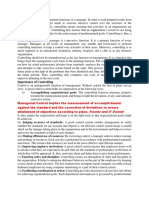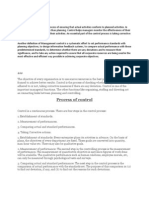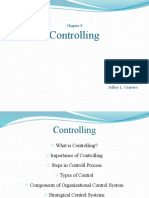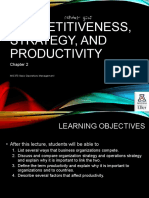Controlling
Controlling
Uploaded by
Seema ModiCopyright:
Available Formats
Controlling
Controlling
Uploaded by
Seema ModiCopyright
Available Formats
Share this document
Did you find this document useful?
Is this content inappropriate?
Copyright:
Available Formats
Controlling
Controlling
Uploaded by
Seema ModiCopyright:
Available Formats
CONTROLLING
Controlling can be defined as that function of management which helps to seek planned results from the
subordinates, managers and at all levels of an organization. The controlling function helps in measuring
the progress towards the organizational goals & brings any deviations, & indicates corrective action.
Controlling helps managers monitor the effectiveness of their planning, organizing, and leading activities.
Controlling determines what is being accomplished — that is, evaluating the performance and, if
necessary, taking corrective measures so that the performance takes place according to plans. Control is a
primary goal-oriented function of management in an organisation. It is a process of comparing the actual
performance with the set standards of the company to ensure that activities are performed according to the
plans and if not then taking corrective action.
IMPORTANCE OF CONTROLLING
1. Accomplishing Organizational Goals The controlling function is an accomplishment of
measures that further makes progress towards the organizational goals & brings to light the
deviations, & indicates corrective action. Therefore it helps in guiding the organizational goals
which can be achieved by performing a controlling function.
2. Judging Accuracy of Standards A good control system enables management to verify whether
the standards set are accurate & objective. The efficient control system also helps in keeping
careful and progress check on the changes which help in taking the major place in the
organization & in the environment and also helps to review & revise the standards in light of such
changes.
3. Making Efficient use of Resources Another important function of controlling is that in this, each
activity is performed in such manner so an in accordance with predetermined standards & norms
so as to ensure that the resources are used in the most effective & efficient manner for the further
availability of resources.
4. Improving Employee Motivation Another important function is that controlling help in
accommodating a good control system which ensures that each employee knows well in advance
what they expect & what are the standards of performance on the basis of which they will be
appraised. Therefore it helps in motivating and increasing their potential so to make them & helps
them to give better performance.
5. Ensuring Order & Discipline Controlling creates an atmosphere of order & discipline in the
organization which helps to minimize dishonest behavior on the part of the employees. It keeps a
close check on the activities of employees and the company can be able to track and find out the
dishonest employees by using computer monitoring as a part of their control system.
6. Facilitating Coordination in Action The last important function of controlling is that each
department & employee is governed by such predetermined standards and goals which are well
versed and coordinated with one another. This ensures that overall organizational objectives are
accomplished in an overall manner.
FEATURES OF CONTROLLING
An effective control system has the following features:
It helps in achieving organizational goals.
Facilitates optimum utilization of resources.
It evaluates the accuracy of the standard.
It also sets discipline and order.
Motivates the employees and boosts employee morale.
Ensures future planning by revising standards.
Improves overall performance of an organization.
It also minimises errors.
PROCESS OF CONTROLLING
1. Establishing standards: This means setting up of the target which needs to be achieved to meet
organisational goals eventually. Standards indicate the criteria of performance. Control standards
are categorized as quantitative and qualitative standards. Quantitative standards are expressed in
terms of money. Qualitative standards, on the other hand, includes intangible items.
2. Measurement of actual performance: The actual performance of the employee is measured
against the target. With the increasing levels of management, the measurement of performance
becomes difficult.
3. Comparison of actual performance with the standard: This compares the degree of difference
between the actual performance and the standard.
4. Taking corrective actions: It is initiated by the manager who corrects any defects in actual
performance. Controlling process thus regulates companies’ activities so that actual performance
conforms to the standard plan. An effective control system enables managers to avoid
circumstances which cause the company’s loss.
TYPES OF CONTROL There are three types of control viz.,
1. Feedback Control: This process involves collecting information about a finished task, assessing that
information and improvising the same type of tasks in the future. In feedback control, after the projects or
activities are completed analysis and observation take place. Identification of whether or not the projects
meet the standard is identified. If standard and actual performance matches the same strategy may be
applied in the future.
2. Concurrent control: It is also called real-time control. It checks any problem and examines it to take
action before any loss is incurred. Thus, this control is associated with adjusting a performance before any
high damage is done. The main purpose of real-time control is to solve problems before they become
major issues. For example, the ship’s movements are navigated by a sailor continuously. Also, a driver adjusts
the steering of its car continuously.
3. Predictive/ feedforward control: It is a preventive control system that will let you prevent problems
before their occurrence. Pre-control predicts problems that you may face in the future and also tries to
identify steps to resolve such problems.
Pre-control system’s aim is to ensure there will be no deviation during the job done. Organizations‘
policies, strategies, and procedures are examples of pre-control systems
Relationship between Planning and Controlling
Planning and controlling are interrelated and in fact reinforce each other in the sense that-
1. Planning is pre-requisite for controlling. Plans provide the standard for controlling. Thus, without
planning, controlling is blind. If the standards are not set in advance managers have nothing to control.
2. Planning is meaningless without controlling. It is fruitful when control is exercised. It discovers
deviations and initiates corrective measures.
3. Effectiveness of planning can be measured with the help of controlling.
4. Planning is looking ahead and controlling is looking back: Planning is a future oriented function as
it involves looking in advance and making policies for the maximum utilization of resources in future that
is why it is considered as forward looking function. In controlling we look back to the performance which
is already achieved by the employees and compare it with plans. If there are deviations in actual and
standard performance or output then controlling functions makes sure that in future actual performance
matches with the planned performances.
Techniques of Controlling
They often divide these techniques into two categories: traditional and modern
Traditional types of control techniques
1. Budgetary Control: Budgeting simply means showcasing plans and expected results using
numerical information. As a corollary to this, budgetary control means controlling
regular operations of an organization for executing budgets. A budget basically helps in
understanding and expressing expected results of projects and tasks in numerical form. For example,
the amounts of sales, production output, machine hours, etc. can be seen in budgets. The main aim of
budgetary control is to regulate the activity of an organization using budgeting. This process firstly
requires managers to determine what objectives they wish to achieve from a particular activity. After
that, they have to lay down the exact course of action that they will follow for weeks and months.
2. Standard Costing: Under this technique, managers record their costs and expenses for every activity
and compare them with standard costs. This controlling technique basically helps in realizing which
activity is profitable and which one is not.
3. Financial Ratio Analysis: Every business organization has to depict its financial performances using
reports like balance sheets and profit & loss statements. Financial ratio analysis basically compares
these financial reports to show the financial performance of a business in numerical terms.
Comparative studies of financial statements showcase standards like changes in assets, liabilities,
capital, profits, etc. Financial ratio analysis also helps in understanding the liquidity and solvency
status of a business.
4. Internal Audit: This process requires internal auditors to appraise themselves of the operations of an
organization. Generally, the scope of an internal audit is narrow and it relates to financial and
accounting activities. In modern times, however, managers use it to regulate several other tasks. For
example, it can also cover policies, procedures, methods, and management of an organization.
Results of such audits can, consequently, help managers take corrective action for controlling.
5. Break-even analysis: Break-even analysis shows the point at which a business neither earns profits
nor incurs losses. This can be in the form of sale output, production volume, the price of products,
etc. Managers often use break-even analysis to determine the minimum level of results they must
achieve for an activity. Any number that goes below the break-even point triggers corrective
measures for control.
6. Statistical Control: The use of statistical tools is a great way to understand an organization’s tasks
effectively and efficiently. They help in showing averages, percentages, and ratios using
comprehensible graphs and charts. Managers often use pie charts and graphs to depict their sales,
production, profits, productivity, etc. Such tools have always been popular traditional control
techniques.
Modern type of controlling technique
1. Critical path method: Under this technique, managers break down tasks into smaller factions and
define the relationships between them. Next, they mark these relationships on a “network diagram”
using flowcharts and mapping techniques. Changes in one faction, in turn, helps them determine how
other factions will change as well. This process, thus, makes controlling and planning easier and
effective.
2. Management Audit: A management audit is nothing but a systematic evaluation of an
organization’s management and its overall performances. It comprises of a systematic and
comprehensive appraisal of each individual managerial function. Management audit differs from a
statutory or financial audit in terms of its scope and objectives. While accounting audits study
financial performances, management audits deal with managerial activities.
You might also like
- FoM Unit 5 PDFDocument10 pagesFoM Unit 5 PDFFuzail ZaidiNo ratings yet
- Unit 3Document18 pagesUnit 3wosihit898No ratings yet
- Chapter SevenDocument4 pagesChapter SevenAd FikNo ratings yet
- UNIT 5 NotesDocument37 pagesUNIT 5 NotesSurbhiNo ratings yet
- MCA Unit 5Document24 pagesMCA Unit 5vaibhaviagrawal466No ratings yet
- ControllingDocument6 pagesControllingsuhaib shaikhNo ratings yet
- HRMG Unit 5Document10 pagesHRMG Unit 5Hemanth ParakhNo ratings yet
- CONTROLLINGDocument9 pagesCONTROLLINGakianajihyosimNo ratings yet
- Org&Mngt 3rdqtr Wk3!23!24 ControlDocument34 pagesOrg&Mngt 3rdqtr Wk3!23!24 ControlChai Samonte TejadaNo ratings yet
- Unit 5 ControllingDocument69 pagesUnit 5 Controllingaanku5835No ratings yet
- Unit-4 Pme Notes of Btech 6TH SemDocument16 pagesUnit-4 Pme Notes of Btech 6TH Semkashishsehrawat2adNo ratings yet
- Chapter 9 ControllingDocument18 pagesChapter 9 ControllingZyad ElshemyNo ratings yet
- ControllingDocument11 pagesControllingabhijit1980adityaNo ratings yet
- Chapter 8 Chapter 8. Controlling-1599071834870Document3 pagesChapter 8 Chapter 8. Controlling-1599071834870Harsh SahukarNo ratings yet
- Management Controlling FunctionDocument17 pagesManagement Controlling Functionanjukothari86No ratings yet
- Controlling Is One of The Important Functions of A ManagerDocument4 pagesControlling Is One of The Important Functions of A ManagerMelkamu DessalegnNo ratings yet
- ControllingDocument3 pagesControllingLyrine SarmientoNo ratings yet
- Principle of Management Control. 2Document38 pagesPrinciple of Management Control. 2durugofavour64No ratings yet
- Control in ManagementDocument24 pagesControl in Managementshalu vijayNo ratings yet
- POM Unit5Document12 pagesPOM Unit5Geethika KasturiNo ratings yet
- STUDY MAT UNIT VDocument13 pagesSTUDY MAT UNIT Vmangal567caNo ratings yet
- Controlling PPT Team-3Document57 pagesControlling PPT Team-3Vikram Kulkarni100% (1)
- Unit VDocument14 pagesUnit VMohithNo ratings yet
- Dimensions of ControlDocument5 pagesDimensions of ControlJulie MarieNo ratings yet
- Unit 4Document31 pagesUnit 4Vaibhav SareenNo ratings yet
- ControllingDocument14 pagesControllingsukh singhNo ratings yet
- controlling important notes and questionsDocument3 pagescontrolling important notes and questionsvaishanavir2007No ratings yet
- CH 8 ControllingDocument3 pagesCH 8 Controllingshouryasethi98No ratings yet
- Controlling TechniquesDocument40 pagesControlling TechniquesArun PrasadNo ratings yet
- Nature and Process of ControllingDocument25 pagesNature and Process of ControllingCfa Deepti Bindal100% (1)
- Controlling ProcessDocument3 pagesControlling ProcessRavi Kumar RabhaNo ratings yet
- Managerial Control by Gurpreet SinghDocument15 pagesManagerial Control by Gurpreet SinghGuruNo ratings yet
- ControllingDocument3 pagesControllingJeremy PanerioNo ratings yet
- Esigned Kyc Stock PDFDocument3 pagesEsigned Kyc Stock PDFjaijaigs05No ratings yet
- ControllingDocument5 pagesControllingHimkar GuptaNo ratings yet
- MTP Ch 10Document29 pagesMTP Ch 10mulunehamdissa97No ratings yet
- Controlling NotesDocument3 pagesControlling Noteszahran0zannu01No ratings yet
- Fundamentals of Management (FOM) Unit-5Document12 pagesFundamentals of Management (FOM) Unit-5ganeswar8No ratings yet
- PPM Notes Unit - VDocument11 pagesPPM Notes Unit - VHemanth ParakhNo ratings yet
- Fundamentals of Management and Organizational Behaviour: Overview of Planning (Part 2)Document14 pagesFundamentals of Management and Organizational Behaviour: Overview of Planning (Part 2)yo boNo ratings yet
- Controlling As A Management FunctionDocument7 pagesControlling As A Management FunctionZaidielNo ratings yet
- POM UNIT - V (1)Document78 pagesPOM UNIT - V (1)janusara2004No ratings yet
- Controlling UNIT - VDocument75 pagesControlling UNIT - VJoel GiftsonNo ratings yet
- Ch-6-Controlling Function-EditedDocument28 pagesCh-6-Controlling Function-Editedanwar jemalNo ratings yet
- Ge3751 - Pom Unit - V Notes FinalDocument49 pagesGe3751 - Pom Unit - V Notes Finalgces099No ratings yet
- Controlling Definition:: Types of ControlDocument8 pagesControlling Definition:: Types of ControlJhonny English100% (2)
- FOM UNIT 5 MaterialDocument14 pagesFOM UNIT 5 MaterialThoviti Lava KumarNo ratings yet
- Group A ControllingDocument20 pagesGroup A ControllingPitq SalazarNo ratings yet
- mgt 2017 CHAPTER 7Document5 pagesmgt 2017 CHAPTER 7Alemayehu TakeleNo ratings yet
- DS ControllingDocument12 pagesDS ControllingDivya MishraNo ratings yet
- Controlling Jeffrey L. CuarteroDocument30 pagesControlling Jeffrey L. CuarteroangeloNo ratings yet
- ControllingDocument36 pagesControllingkelvinNo ratings yet
- Inflation AccountingDocument24 pagesInflation AccountingAbhinanda BhattacharyaNo ratings yet
- Unit 6 of Principles of ManagementDocument12 pagesUnit 6 of Principles of ManagementShivam Kumar ThakurNo ratings yet
- 8 ControllingDocument4 pages8 Controllingadhishreesinghal24No ratings yet
- CONTROLLINGDocument63 pagesCONTROLLINGPatricia Mae RiveraNo ratings yet
- Chapter 7Document3 pagesChapter 7የገጠር ልጅNo ratings yet
- ControllingDocument9 pagesControllingKundan JhaNo ratings yet
- MGMT - Topic 7 - ControlDocument13 pagesMGMT - Topic 7 - Controlnorliza albutraNo ratings yet
- Balanced Scorecard for Performance MeasurementFrom EverandBalanced Scorecard for Performance MeasurementRating: 3 out of 5 stars3/5 (2)
- Eoq QuestionsDocument13 pagesEoq QuestionsHanabusa Kawaii IdouNo ratings yet
- Mhillu CVDocument1 pageMhillu CVGodfrey FidolinNo ratings yet
- Prelim Exam Logistics ManagementDocument2 pagesPrelim Exam Logistics ManagementAbbegail CalinaoNo ratings yet
- A Study On The Impact of Social Media Marketing Trends On Digital MarketingDocument6 pagesA Study On The Impact of Social Media Marketing Trends On Digital MarketingJohn Ryan Maglente AnsitNo ratings yet
- Sanjna Chimnani: Education SkillsDocument1 pageSanjna Chimnani: Education SkillsSanjna ChimnaniNo ratings yet
- Competitiveness, Strategy and ProductivityDocument67 pagesCompetitiveness, Strategy and ProductivityQWERTYNo ratings yet
- Test 1: MORSE TYPE. Please Refer To The Table Below For Your AnswersDocument6 pagesTest 1: MORSE TYPE. Please Refer To The Table Below For Your AnswersRommel RoyceNo ratings yet
- ASP Group 2024Document10 pagesASP Group 2024farzanaisadeborderNo ratings yet
- SMRP Metric 5.5.38 Storeroom Maintenance Material CostDocument5 pagesSMRP Metric 5.5.38 Storeroom Maintenance Material CostJorge FracaroNo ratings yet
- Power Users, Personas, - Customer Acquisition ChannelsDocument8 pagesPower Users, Personas, - Customer Acquisition ChannelsIngrosso SethNo ratings yet
- Generic Producer Retailer CRT For StudentsDocument2 pagesGeneric Producer Retailer CRT For StudentsJanaNo ratings yet
- Amaranth AdvisorsDocument15 pagesAmaranth AdvisorsRani ZahrNo ratings yet
- 812 Marketing MsDocument6 pages812 Marketing Mssajibr1970No ratings yet
- Lidl Romania - Retail Marketing ProjectDocument6 pagesLidl Romania - Retail Marketing ProjectCristina ȘișcanuNo ratings yet
- GiẠI Quiz VI MãDocument25 pagesGiẠI Quiz VI MãhaNo ratings yet
- Module 5 2nd Quarter EntrepDocument10 pagesModule 5 2nd Quarter Entrepraymart fajiculayNo ratings yet
- Mcom QP Amd 40 MarksDocument2 pagesMcom QP Amd 40 Marksirfanahmed.dbaNo ratings yet
- Ch09 HW SolutionsDocument11 pagesCh09 HW Solutionsgilli1tr100% (2)
- Royal Canin IndiaDocument97 pagesRoyal Canin IndiasahilmkkrNo ratings yet
- Straight Problems 1Document3 pagesStraight Problems 1Krishele G. GotejerNo ratings yet
- 24 Unrestricted Copywriting PLR Articles Pack LicenseDocument2 pages24 Unrestricted Copywriting PLR Articles Pack LicenserlfudgeNo ratings yet
- Northern Mindanao Colleges, Inc.: Self-Learning Module For Principles of Marketing Quarter 1, Week 4Document6 pagesNorthern Mindanao Colleges, Inc.: Self-Learning Module For Principles of Marketing Quarter 1, Week 4Christopher Nanz Lagura CustanNo ratings yet
- Section B Questions and Answers. Each Question Carries 5 Marks 1. Distinguish Between Accounting and Auditing. (2012, 2013)Document8 pagesSection B Questions and Answers. Each Question Carries 5 Marks 1. Distinguish Between Accounting and Auditing. (2012, 2013)sadathnooriNo ratings yet
- Final AccountsDocument20 pagesFinal Accountsabhimanbehera0% (1)
- Review of LiteratureDocument9 pagesReview of Literatureasir immanuvelNo ratings yet
- Head of SaleDocument4 pagesHead of Salekeo linNo ratings yet
- Project Report On Dairy FarmDocument17 pagesProject Report On Dairy FarmharishankarNo ratings yet
- Business Analysis SyllabusDocument6 pagesBusiness Analysis SyllabusQuynh AnhNo ratings yet
- DCF Group 5Document18 pagesDCF Group 5Ravi Kumar100% (1)
- Fyba External Economics Paper - 1 (CC) (Principal) Hj-2115Document4 pagesFyba External Economics Paper - 1 (CC) (Principal) Hj-2115It's tejNo ratings yet

























































































